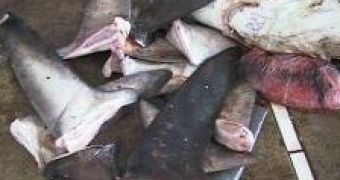Researchers from the University of Hawaii and elsewhere estimate that the numbers of sharks caught around the world are three to four times higher than the figures published by the UN Food and Agriculture Organization based on inventories of shark fin sales at auctions in Hong Kong. "It is not a question of blaming the FAO," says Shelley Clarke, an American fisheries scientist who works in Hong Kong and Japan. "But it highlights the scepticism we should have about fisheries data," she adds.
"The shark fin trade is notoriously secretive. But we were able to tap into fin auction records and convert from fin sizes and weights to whole shark equivalents to get a good handle on the actual numbers," said Clarke.
Converting the data of shark fin to shark weights, they estimated that about 1.7 million tons of shark flesh is harvested each year. It means about 73 million sharks per year !
The FAO's estimates a catch of 0.39 to 0.60 million tons per year. This is the first fishery-independent estimate of the global shark catch for the shark fin trade.
Fins are by far the most valuable parts of a shark and are the main ingredient in shark fin soup, a delicacy served at Chinese weddings and business dinners in Southeast Asia and the Pacific Rim. Sharks are often thrown still alive in the sea with their fins cut, suffering an agonizing death.
The demand for shark fin keeps growing with that for seafood, up to 5 % per year in mainland China. This demand has grown beyond sustainable levels for slow reproductive shark populations and triggers concern about regulation in most countries.
The endurance of the shark populations depends upon the size and status of each population. Three shark species are listed on the Convention on International Trade in Endangered Species of Wild Flora and Fauna (CITES), and 20 percent are threatened with extinction according to the 2006 Red List of Threatened Species. The blue shark is already critically endangered by the fin trade. "One of the most productive sharks is the blue shark, and it appears that the catch rate is near the maximum sustainable level," says Clarke.
"But such assessments were not available for other, less productive shark species. It is quite likely that sustainable catch levels have already been exceeded in some cases."
The United Nations FAO compiles catch records based on information submitted from member countries. Where possible, the FAO attempts to verify the accuracy of the figures, but verification is often not practical. Many sharks may be recorded as unidentified fish and thus not be recognizable as sharks in the FAO records. "Due to the low value of shark meat in many markets, shark fins may be the only part of the shark retained, and often these fins are not recorded in the catch log or when landed at ports.
I knew we had to somehow access the major markets if we were to accurately estimate the number of sharks killed," says Ellen Pikitch, Ph.D., executive director of the University of Miami's Pew Institute for Ocean Science.
The overfishing of sharks could seriously damage entire ecosystems. A recent study in a reef environment in the Caribbean Sea showed that without the sharks, a whole ecosystem can be turned upside down. Carnivorous fish, the main food item for the sharks, thrived on their absence. These fishes preyed intensively on parrotfish that kept the corals clean. Their absence turned the reef in an algae dominated area.
Photo credit: Dr. Shelley Clarke. A mixture of shark fins in a fish market in Taiwan. Among the species dusky, sand, and thresher sharks.

 14 DAY TRIAL //
14 DAY TRIAL //